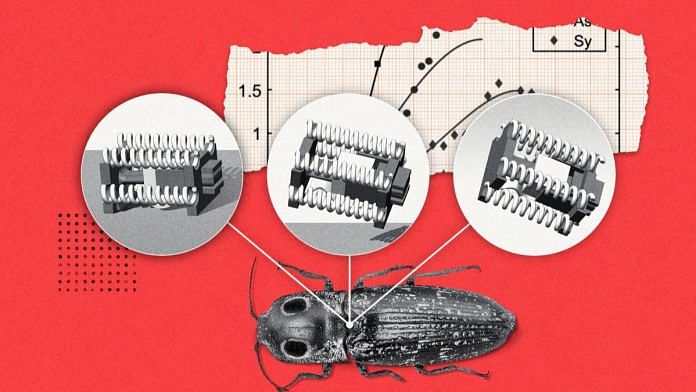New Delhi: Scientists have created beetle-sized jumping robots capable of performing tasks in small spaces and that are powerful enough to manoeuvre over obstacles.
The team at the University of Illinois Urbana-Champaign and Princeton University studied the click beetle’s anatomy, mechanics and evolution over the past decade. In 2020, they found that snap buckling — the rapid release of elastic energy — of a coiled muscle within a click beetle’s thorax is triggered to allow them to propel themselves in the air many times their body’s length as a means of righting themselves if flipped onto their backs.
The team then used tiny coiled actuators — similar to animal muscles — that pull on a beam-shaped mechanism, causing it to slowly buckle and store elastic energy until it is spontaneously released and amplified, propelling the robots upward.
Guided by biological evolution and mathematical models, the team built and tested four device variations, landing on two configurations that can successfully jump without manual intervention.
The team envisions these robots accessing tight spaces to help perform maintenance on large machines like turbines and jet engines, for example, by taking pictures to identify problems. Read more
Also read: Rare 7kg meteorite found in Antarctica, one of five new space rocks discovered
Meteoritic delivery of Earth’s potassium
Earth’s potassium arrived by meteoritic delivery service, shows new research which elucidates the processes that shaped our solar system and determined the composition of its planets.
The study, led by researchers at Carnegie University, shows that some primitive meteorites contain a different mix of potassium isotopes than those found in other, more-chemically processed meteorites.
“The extreme conditions found in stellar interiors enable stars to manufacture elements using nuclear fusion. Each stellar generation seeds the raw material from which subsequent generations are born and scientists can trace the history of this material across time,” said Carnegie’s Nicole Nie
Some of the material produced in the interiors of stars can be ejected out into space, where it accumulates as a cloud of gas and dust. More than 4.5 billion years ago, one such cloud collapsed in on itself to form our sun.
The remnants of this process formed a rotating disk around the newborn star. Eventually, the planets and other solar system objects coalesced from these leftovers, including the parent bodies that later broke apart to become asteroids and meteorites. By studying variations in the isotopic record preserved within meteorites, the source materials from which they formed can be traced. This helps scientists build a geochemical timeline of the solar system’s evolution.
The team measured the ratios of three potassium isotopes in samples from 32 different meteorites.
Potassium is interesting since it is what is called a ‘moderately volatile element’, which are named for having relatively low boiling points that cause them to evaporate fairly easily.
As a result, it’s challenging to look for patterns that predate the sun in the isotopic ratios of volatiles. Read more
AI tools can edit genes faster
Scientists have created an artificial intelligence (AI) programme that may enable the first simple production of customisable proteins called ‘zinc fingers’ to treat diseases by turning genes on and off.
Researchers from the New York University and the University of Toronto, who designed the tool, say the advance could help accelerate the development of gene therapies on a large scale.
Illnesses including cystic fibrosis, Tay-Sachs disease, and sickle cell anaemia are caused by errors in the order of DNA letters that encode the operating instructions for every human cell. Scientists can, in some cases, correct these mistakes with gene editing methods that rearrange these letters.
Other conditions are caused, not by a mistake in the code itself, but by problems in the epigenetic activity — that is, how the cellular machinery reads DNA. Researchers have been exploring ways to restore normal epigenetic activity.
One such technique is zinc-finger editing, which can both change and control genes.
The new technology, called ZF Design, can identify the right grouping of zinc fingers for any modification, making this type of gene editing faster than ever before. Read more
Scientist set new record for shortest electron pulse
By using ultrafast laser flashes, scientists have broken a new record by generating the shortest electron pulse to date, lasting just 53 attoseconds (one attosecond is the billionth of a billionth of a second).
The electron pulse was created at the University of Rostock in collaboration with researchers of the Max Planck Institute using lasers to remove electrons from a tiny metal tip.
The research opens new avenues for advancing the performance of electronics and information technologies, as well as developing new scientific methodologies for visualising phenomena in the microcosm at ultimate speeds.
The time it takes electrons to stream out from minute leads inside the transistors of electronic microchips and to form pulses is what determines whether a computer or other electronic gadgets are slow or fast in their performance.
Methods to speed up this process are central for advancing electronics and their applications. Read more
Also read: James Webb telescope spots its first exoplanet — Earth-sized but may be ‘not Earth-like



